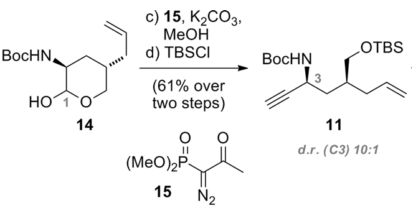Giantassio, Lopchuk et al. (Baran lab) (Science)
As the legend goes, people from Pfizer approached Phil Baran and told him “You know, we figured out what our problem is. We need more propellers on our molecules.” Phil said “OK, sounds like a good project” and put two grad students on it. Results: the 3-in-1 Science paper, with propellers spinning on every amine, SI, which is longer than my PhD thesis, and happy Pfizer counting cash.

By the way, Baran lab has a cold room for synthesis.

Qi et al. (Porco lab) (JACS)
Electrocyclic reactions are always fun, especially when 2 in 1. See the paper for stereoselective one.

Schuler et al. (Nat Chem)
How to monitor progress of Bergman cyclization at 1.66 yoctomole scale? Atomic force microscopy is the answer.

Zhao, Ming et al. (Org Lett)
Looks trivial until you try to push the electrons. The side-product hints at the mechanism.

Feng et al. (Tet Lett)
Another magic reaction candidate for debunking? Thanks sash-2003 for heads up.

And before you rush to check it, they do report detection of molecular hydrogen in the gas mixture coming from the reaction.













